
Chinese and Japanese numerals are the same. Numerals makes up a small part of the marks on Chinese and Japanese porcelain however they do occur. Many numbers have a symbolic meanings in Asian cultures and this could be referred to by the number itself of the number of times a particular character or symbol occurs in the decoration.
While 2, 3, 5 and 8 are common the number 4 is often avoided in Chinese culture because it is considered unlucky. This stems from the fact that the word for "four" (四, pinyin: sì) sounds very similar to the word for "death" (死, pinyin: sǐ) in Mandarin and several other Chinese dialects.
The Japanese numerals in writing are entirely based on the Chinese and the grouping of large numbers also follow the Chinese tradition. Traditionally text and numbers were written from top to bottom or right to left. Around mid 20th century in China numbers started to be written from left to right, see for example "25" below. In Japan inscriptions on coins were reversed from the 23rd year of Showa (1948) and from then on, were read from left to right.
The explanations regarding the symbolic meaning of different numbers are referring to Chinese traditions which are similar in both China and Japan, except naturally for the same sounding homonyms.
| Chinese and Japanese numerical characters | ||
|---|---|---|
| 1 | 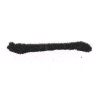 |
The number 1 (Pinyin: yi) sounds similar to the character for "together" and "want" in Mandarin, and is thus considered a lucky number. |
| 2 | 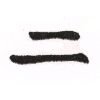 |
The number 2, (Pinyin: er) is a good number in Chinese culture. It is common to use double symbols in product brand names, such as double happiness, double coin and double elephants. In Cantonese "two" is a homophone of the character for "easy". |
| 3 | 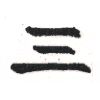 |
The number 3 (Pinyin: san) sounds similar to the character for "earn" and "live" and is thus considered a lucky number. |
| 4 | 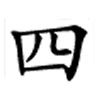 |
The number 4 (Pinyin: si) is considered an unlucky number in Chinese, Korean, and Japanese cultures because it is nearly homo phonic to the word "death". This is taken very serious and anything that includes the number "four" including house numbers, floor number, phone numbers and car license number is rendered very unattractive. |
| 5 | 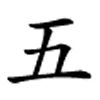 |
The number 5 (Pinyin: wu) was within Daoism associated with the five elements (water, wood, fire, earth and metal) and a very important number within Chinese symbolism. It occurs widely within both architecture and all kinds of decorative arts. |
| 6 | 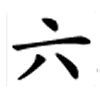 |
The number 6 (Pinyin: liù) is pronounced similar to "smooth" (Pinyin: liu) and is considered good for business. The number 6 also represents happiness. In Cantonese, this number is a homophone for blessings (lok). |
| 7 | 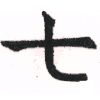 |
The number 7 (Pinyin: qi) symbolizes "togetherness" and is a lucky number for relationships. |
| 8 | 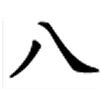 |
The word for "eight" (Pinyin: ba) sounds similar to the word which means "fortune", "prosper" or "wealth". |
| 9 | 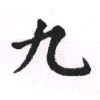 |
The number 9 (Pinyin: jiu) is a homophone with "jiu" meaning "long time" in Mandarin. Nine being the greatest of single-digit numbers was also historically associated with the Emperor of China. In Daoistic symbolism the number eight represents all possible horizontal direction while adding one vertical, would render the number 9 adding the direction up-down as in the relation between heaven and earth. |
| 10 | 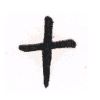 |
|
| 100 | 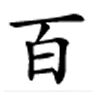 |
|
| 1,000 |  |
|
| 10,000 | 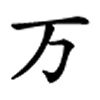 |
The number 10,000 (Pinyin: wan) is sometimes also used with the meaning "many" or "innumerable". |
| 25 | 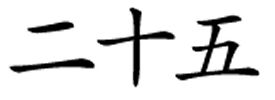 |
The numbers above are basic numbers with special characters for large numbers like hundred, thousand and so on. To have any number in between these, the numbers needs to be combined much like Roman numbers. This is for example 25 made up by 2 [times] 10 [plus] 5 |
Web page © Jan-Erik Nilsson 2010
The marks section of Gotheborg.com was initially established in May 2000 thanks to a generous donation of approximately one hundred images of Japanese porcelain marks, by Karl-Hans Schneider from Euskirchen, Germany. This contribution provided a modest yet substantial beginning of the Marks Section. It was a kind gesture that I really appreciated.
Of the many later contributors, I would especially want to mention Albert Becker, Somerset, UK, who was the first to help with some translations and comments on the Japanese marks. His work was then greatly extended by Ms. Gloria S. Garaventa, after which Mr. John Avery looked into and corrected some of the dates. Most of the Satsuma marks were originally submitted by Ms. Michaela Russell, Brisbane, Australia. A section which was then greatly extended by Ian & Mary Heriot, a large amount of information from which still awaits publication.
A warm thank you also goes to John R. Skeens, Florida, U.S.A., and Toru Yoshikawa for the Kitagawa Togei section, and to Susan Eades for her help and encouragement towards the creation of the Moriyama section. For the last full overhaul of the Satsuma and Kutani sections, thank you to Howard Reed, Australia. The most recent larger contribution was made by Lisa M. Surowiec, New Jersey, USA.
In 2004 and from then on, my warm thank you goes to John Wocher and Howard Reed, whose knowledge and interest have sparked new life into this section and given reason for a new overhaul. Thank you again and thank you to all I have not mentioned here, for all help and interest in and contributions to our knowledge of 20th-century Japanese porcelain.
The Chinese marks section would not have been possible without the dedicated help of Mr. Simon Ng, City University of Hong Kong, whose translations and personal efforts in researching the origin and dates of the different marks have been an invaluable resource. It has since been greatly extended by several contributors such as Cordelia Bay, USA, Walt Brygier, USA, Bonnie Hoffmann, Harmen Lensink, 'Tony' Yalin Zhang, Beijing, 'ScottLoar', Shanghai, Mike Harty, and many more expert members of the Gotheborg Discussion Board.
A number of reference pieces have also been donated by Simon Ng, N K Koh, Singapore, Hans Mueller, USA, Hans Slager, Belgium, William Turnbull, Canada, and Tony Jalin Zhang, Beijing.
All images and text submitted by visitors and published anywhere on this site are and remain the copyrighted property of the submitter and appears here by permission of the owners which can be revoked at any time. All information on this site, that are not specifically referenced to peer reviewed sources, are the personal opinions given in good faith by me, my friends and fellow experts, based on photos and the owners' submitted descriptions. They are not to be used for any financial or commercial decisions, but for educational and personal interest only, and can and will be changed as further information merits.
For further studies, Encyclopedia Britannica is to be recommended in preference to Wikipedia, which, not being peer-reviewed, might contain misleading information.
Web design and content as it appears here © Jan-Erik Nilsson 1996-.